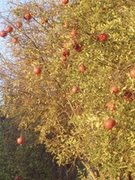One of the delights of being an auntie and a godmother is cooking with my nephew and niece.
Two weeks ago we made the Christmas Cake, yesterday the Marzipan (there was none left pre-made in the stores!) and today I iced the cake with Royal icing.

Ella, Finn and I had great fun making the cake. Ella (22 months) concentrated intently on cutting the butter, sifting the flour, measuring the sugar and mixing the flour and the dried fruits, and spooning the mixture in to the tin. Finn (nearly 5) was in charge of keeping an eye on the mixer as the butter and sugar creamed, and then the eggs were added one by one.
The recipe was based on the Cordon Bleu cookery course my mother subscribed to in weekly installments when I was a baby. Week 20 had the Christmas cake in it. Its the same recipe we used when I was a child, and I recall making it on my own for the first time when I was 8 or 9.
A warning though, if you plan on letting your 9 year old loose in the kitchen. I did a lot of cooking from a very young age, and was mostly fine on my own. But then there was the day I put half a pound of butter on to melt for icing for a banana cake (way too much butter!) Being inclined to rush things I put it on high. And then went and watched some TV and forgot about it..until the smell of smoke reached my parents who were wallpapering at the other end of the house, and came to the kitchen to find the wall on fire. Luckily, Mum had been reading a book on fire safety to my brother the night before, and remembered the best way to put out an oil fire was to soak a towel in water and put it on the pan. This did most of the work, the extinguisher the rest, and I was very much persona non grata a for a while....
Anyway, on to happier things, here is the recipe as we made it two weeks ago. I've adapted to metrics from the original to use the premix dried fruit rather than individual measures, and indicated where a 2 or 5 year old helper can join in.
Family Christmas CakeLine a 20cm cake tin (round or square) with a double thickness of greaseproof paper.
Heat the oven to 180 degrees.
Dice 200g butter (if using from the fridge). Your 2 year old can be kept happy by cutting the butter into smaller bits using a toddler's knife (Bob the Builder worked well for us!) then puttin gthe butter into the mixing bowl. Cutting it helps it soften prior to creaming it with sugar.
Have your 5 year old measure 1 cup of flour (about 8 oz/225 g), 1/2 t cinnamon and 1/2 t into a bowl. The 2 year old can add a pinch of salt.
Set a sieve over another bowl and have the 2 year old empty the flour into the sieve, bit by bit, shaking and stirring the sieve until it all goes through.
Mix half the flour with a 500g packet of mixed dried fruit (sultanas, raisins, mixed peel, cherries, currants are in the mix we used) and 100-150 g shredded almonds.

At this stage your two year old can use her hands to mix the flour until all the fruit is covered. There's quite a lot of fruit so it may be worth splitting it into 2 smaller dishes or a roasting dish to make it easier on your toddler.
While she or he is doing this, beat the butter in a mixer until soft, then add the rind of half a lemon or orange, and 180 g soft brown sugar and cream until light and fluffy.
Have a child break 4 eggs into a cup, one at a time, beat each with a fork (the Bob the Builder fork worked here :-) abefore adding them to the sugar/butter mixture, beating well between each one.
Use a metal spoon to fold in half the flour. Then add the dried fruit and 1 T of orange juice or 2 T of sherry or brandy.
Get everyone in the family to give a stir, before spooning into the tin.
With wet hands, gently pat the top so there is a fine film of warm water to keep the cake moist.
Put the cake in the middle of the oven set at 180 degrees. After 1 hour, reduce the temperature to 165 degrees. Test again after a further 45 minutes, using a skewer (5 year olds can weild the skewer if an adult holds the hot cake. It's done when the skewer comes out clean.
Once cooked, take out, and cool in the tin, before wrapping in greaseproof paper and storing in an airtight container for a couple of weeks before icing. You can pour over a spoonful or two of brandy while it matures, or just eat it as it is.




